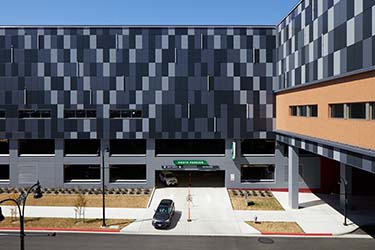|
Subscribe / Renew |
|
|
Contact Us |
|
| ► Subscribe to our Free Weekly Newsletter | |
| home | Welcome, sign in or click here to subscribe. | login |
Architecture & Engineering
| |
 |
March 4, 2021
Parking garages: rethinking your front door
PCS Structural Solutions

Plank
|
A patron’s first experience with your building is when they enter the garage. How can you make this experience more inviting? Your challenge is to create a parking garage that is more than just a utilitarian structure, but also an inviting and welcoming extension of your building entrance. Focus your parking structure design on user experience — efficiency, functionality, and aesthetics.
The appearance of the parking garage facade will be one of the first impressions patrons will have as they enter. Ensure that the design visually aligns with adjoining structures and is aesthetically pleasing. Your structural engineer can assist the architect in finding ways to express the structure directly or provide facade support to efficiently screen unfavorable elements. Two points to always keep in mind: Blocking off the exterior affects the interior openness and may require additional fire protection and ventilation. Secondly, enclosing the facade may have a negative effect on your guests’ safety perception, especially at stairs and elevators.
Let your signage be the first glimpse into the user’s overall experience. It can be panic-inducing for a first-time parker to enter a garage. Designing a clear path to open parking spaces and then lobbies is key to ensuring guest comfort. Level and location indicators help guide individuals to and from their vehicles. User-friendly ramping systems help guests easily find their way through the garage and back to their vehicles.
Lobbies need to be bright, obvious, clean, and unobstructed so patrons can feel safe approaching and leaving. Working with the structural engineer and parking functional designer to locate stairs and elevators is imperative to ensure efficiency and structural simplicity. Stair and elevator access points are ideally situated in the corners of the parking structure or offset from the structure. These locations offer the potential of increased parking efficiency and lower construction cost.
Skybridges and at-grade pedestrian connectors should be well thought out and placed in ideal travel path areas. Since the cost for skybridges may be north of $10,000 per lineal feet, it’s important to find efficient and direct paths to cut down on costs and unnecessary pedestrian travel. Your users will appreciate it too!
Your design team can assist in a multitude of structural options for both skybridges and at-grade pedestrian connectors. At-grade connectors should be well aligned with main entrances to avoid zig-zags and hiding places. Straight and short segments are ideal for occupant safety.
Adequate lighting helps patrons feel safe and see tripping objects. Parking structures generally have higher light level requirements than surface lots. In the book Parking Structures, by Anthony Chrest, Mary Smith, et al., the minimum recommended illuminance inside a structure is 1 foot-candle (fc) with an average of 4 fc. For the highest level of service, provide a minimum of 4 fc and an average of 10 fc.
A taller space will generally feel more open and accommodating. Select a structural system that conforms to the site and makes the most of the available height. The most common systems for stand-alone garages are cast-in-place concrete with post-tensioning and precast/prestressed concrete. Each have their pros and cons, but the spacing of the beams greatly affects the perception of floor height. The more spaced out the beams, the higher the floor-to-floor height feels.
Below-grade parking is an excellent choice in dense urban areas or on steep sites. However, parking below grade generally comes at a higher cost due to excavation, fire sprinklers, ventilation, and waterproofing. The cost of parking below grade exponentially increases with depth. When parking is needed and ideal for a site, make sure column layout functions well with above-grade uses for best efficiency. When columns from spaces above can’t align with parking layout below, consider using transfer beams to allow flexibility between uses. If more than two levels of parking can benefit from using a transfer beam and a significant number of spaces can be gained, the transfer may pay for itself.
As ride-sharing becomes more prevalent, drop-off/pickup signs are increasingly important. They need to be functional, clearly marked and close to lobbies. Relegating these locations to back corners should be avoided for safety and perception of users.
Placement of reserved spaces should be well thought out to ensure that visitors are given preference. Reserving all spaces on the first floor for VIP, for example, should be avoided to limit visitors passing multiple open, but unusable spaces.
In addition, the need for electric vehicle parking continues to increase. Clear signage is important so that users can find the proper stall.
Structural costs for parking structures range from 70% to 80%. For some other types of construction, this number may be as low as 10%. Thus, structural system layout, span, orientation, size, and ramping are all critical to keeping costs low and quality high. Experienced structural engineer and parking functional designer involvement early in design is critical for project success.
While parking structures serve a simple, practical purpose, they provide an important opportunity to make an impression with your guests. Your customer service begins the moment they enter your structure. Providing a clear, clean path to the front door will make the experience positive and prepare users for good outcomes in your facility.
Jared Plank is a structural engineer with PCS Structural Solutions and a market leader in hospitality and private development.
Other Stories:
- How to keep the creative spark in a virtual world
- It’s the end of the grocery store (as we know it)
- Are American shopping malls boxed-in?
- Influencing human scale, creating a sense of place
- Here are the 3 principles of renovation
- The future of resilient commercial real estate
- Not all feasibility studies are created equal
- Green Lake Community Center aims for inclusivity
- What if you can’t dig your way out of a brownfield cleanup?
- The role of ventilation and healthy air
- How A/E firms can increase proposal success in 2021
- Workplace wellness through technology
- 4 Living Buildings: collaborative, courageous, open-minded learning
- Foundations for healthy and sustainable urban places
- A changed workforce and the implications for workplaces and cities



